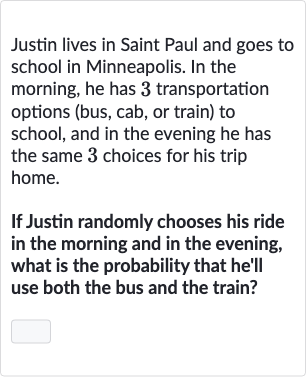AI tutor
Welcome to Bytelearn!
Let’s check out your problem:

Justin lives in Saint Paul and goes to school in Minneapolis. In the morning, he has transportation options (bus, cab, or train) to school, and in the evening he has the same choices for his trip home.If Justin randomly chooses his ride in the morning and in the evening, what is the probability that he'll use both the bus and the train?
Full solution
Q. Justin lives in Saint Paul and goes to school in Minneapolis. In the morning, he has transportation options (bus, cab, or train) to school, and in the evening he has the same choices for his trip home.If Justin randomly chooses his ride in the morning and in the evening, what is the probability that he'll use both the bus and the train?
- Calculate possible combinations: Justin has options in the morning and options in the evening, making a total of possible combinations for his daily commute.
- Bus and train options: To use both the bus and the train, Justin can choose either the bus in the morning and the train in the evening, or the train in the morning and the bus in the evening.
- Identify favorable outcomes: There are favorable outcomes: (bus then train) or (train then bus).
- Calculate probability: The probability that Justin will use both the bus and the train is the number of favorable outcomes divided by the total number of possible combinations.
- Final probability calculation: So, the probability is
